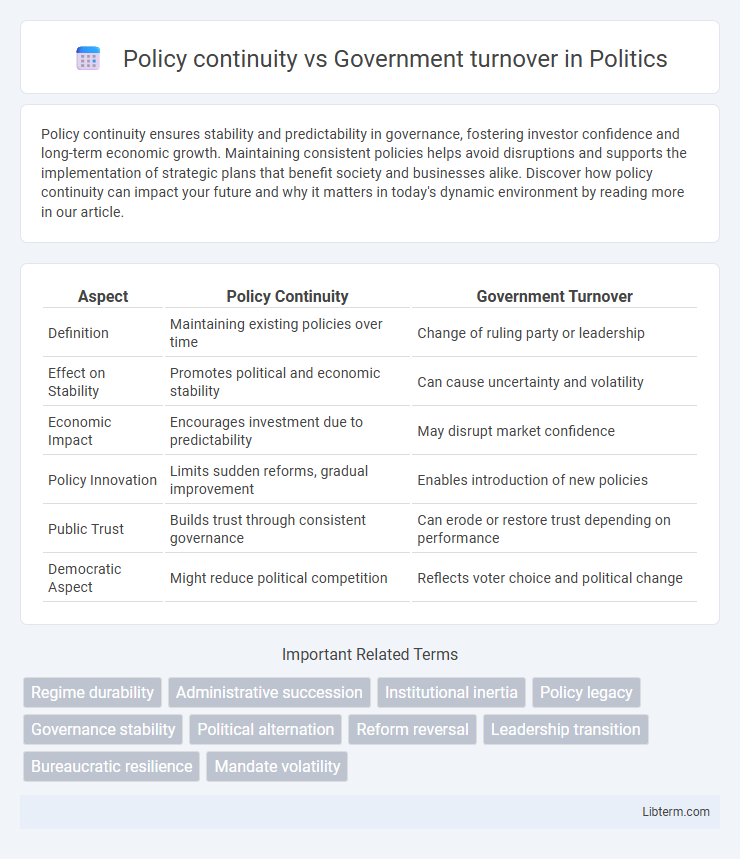Policy continuity ensures stability and predictability in governance, fostering investor confidence and long-term economic growth. Maintaining consistent policies helps avoid disruptions and supports the implementation of strategic plans that benefit society and businesses alike. Discover how policy continuity can impact your future and why it matters in today's dynamic environment by reading more in our article.
Table of Comparison
| Aspect | Policy Continuity | Government Turnover |
|---|---|---|
| Definition | Maintaining existing policies over time | Change of ruling party or leadership |
| Effect on Stability | Promotes political and economic stability | Can cause uncertainty and volatility |
| Economic Impact | Encourages investment due to predictability | May disrupt market confidence |
| Policy Innovation | Limits sudden reforms, gradual improvement | Enables introduction of new policies |
| Public Trust | Builds trust through consistent governance | Can erode or restore trust depending on performance |
| Democratic Aspect | Might reduce political competition | Reflects voter choice and political change |
Introduction to Policy Continuity and Government Turnover
Policy continuity ensures the consistent implementation of laws and regulations despite changes in leadership or political parties, preserving long-term governmental objectives and public trust. Government turnover refers to the transition of political authority, typically following elections or shifts in power, which can lead to significant changes in policy direction and administrative priorities. Understanding the balance between policy continuity and government turnover is crucial for stable governance and effective public administration.
Defining Policy Continuity: Key Concepts
Policy continuity refers to the sustained implementation of governmental strategies and regulations across different political administrations, ensuring stability in public governance. It involves maintaining core policy objectives and institutional frameworks despite changes in government personnel or ruling parties. Key concepts include institutional resilience, agenda persistence, and the balance between innovation and stability in policy-making processes.
Understanding Government Turnover: Causes and Types
Government turnover occurs when there is a change in the governing administration, often triggered by elections, resignations, or votes of no confidence. Causes include political instability, shifts in public opinion, or internal party conflicts, which can lead to abrupt or gradual transitions. Types of government turnover vary from peaceful democratic transitions to abrupt coups or caretaker governments, each influencing the continuity of policy implementation differently.
Historical Perspectives on Policy Changes Amid Leadership Shifts
Historical perspectives reveal that policy continuity often faces challenges during government turnover due to shifts in political ideology, party priorities, and leadership agendas. Key examples include the New Deal policies in the United States, which saw partial reversals during subsequent administrations, and post-war European social welfare programs that experienced modifications as governments changed. The tension between maintaining long-term policy frameworks and adapting to new leadership priorities shapes the evolution of governance across democratic and authoritarian regimes.
Impacts of Government Turnover on Long-Term Policy Implementation
Frequent government turnover disrupts long-term policy implementation by causing shifts in priorities, leading to inconsistent funding and program management. Such instability hampers the achievement of strategic goals, undermines stakeholder confidence, and increases administrative costs. Continuity in policy ensures sustained development, effective resource allocation, and improved public trust in governance.
Case Studies: Successes and Failures in Policy Continuity
Case studies in policy continuity during government turnover reveal mixed outcomes, highlighting the importance of institutional frameworks and political will. In countries like Germany, robust bureaucratic structures ensured successful continuation of social welfare policies despite changes in administration, whereas in Venezuela, frequent government turnovers often led to abrupt policy shifts, undermining economic stability. Effective policy continuity often depends on bipartisan support and legal mechanisms that transcend individual administrations, minimizing disruptions and fostering long-term development goals.
Mechanisms Supporting Policy Continuity During Political Transition
Mechanisms supporting policy continuity during political transitions include institutional frameworks such as independent regulatory agencies, robust civil service systems, and legal mandates that safeguard long-term policy implementation. These structures ensure that essential programs and reforms persist beyond government turnover, minimizing disruption to economic and social initiatives. Stable policy environments foster investor confidence and promote sustained development despite changes in political leadership.
The Role of Institutional Frameworks in Policy Stability
Institutional frameworks play a crucial role in ensuring policy stability amidst government turnover by establishing legal and procedural norms that limit abrupt shifts. Strong institutions, such as independent regulatory bodies and codified policy processes, create continuity by constraining political actors from unilaterally reversing prior policies. Effective frameworks enhance predictability in governance, fostering investor confidence and long-term development despite changes in administration.
Public Trust and Perceptions: Continuity vs. Change
Public trust often hinges on perceptions of policy continuity versus government turnover, where stable policies can foster confidence in governance effectiveness. Frequent government changes may lead to uncertainty, undermining public trust due to perceived instability and inconsistent policy directions. Research suggests that maintaining a balance between continuity in essential policies and introducing necessary reforms sustains public trust while adapting to societal needs.
Strategies for Enhancing Policy Continuity Despite Government Turnover
Strategies for enhancing policy continuity despite government turnover include establishing bipartisan agreements and creating independent policy institutions that operate beyond political cycles. Implementing comprehensive documentation and knowledge management systems ensures smooth transitions and preserves institutional memory. Encouraging stakeholder engagement and fostering long-term planning frameworks help maintain consistent policy implementation regardless of changing administrations.
Policy continuity Infographic

 libterm.com
libterm.com